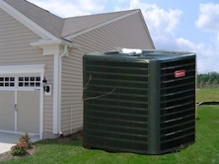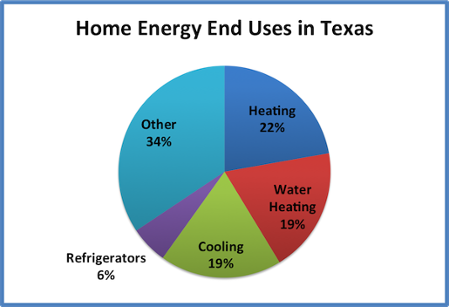Does Texas Use More Energy for Heating or for Cooling?

 Texas is a hot state, right? Certainly then, homes in my original home state use more energy for air conditioning than for heating. That’s why they need such massive air conditioners, like the one you see here. Right? Not so fast. The real answer is yes, they do, but the other real answer is also yes, they do.
Texas is a hot state, right? Certainly then, homes in my original home state use more energy for air conditioning than for heating. That’s why they need such massive air conditioners, like the one you see here. Right? Not so fast. The real answer is yes, they do, but the other real answer is also yes, they do.
Texas is a hot state, right? Certainly then, homes in my original home state use more energy for air conditioning than for heating. That’s why they need such massive air conditioners, like the one you see here. Right? Not so fast. The real answer is yes, they do, but the other real answer is also yes, they do.
What?
OK, let me explain. The US Energy Information Administration (EIA) publishes a lot of data about energy production and consumption, and their 2009 Residential Energy Consumption Survey (RECS) has the answer. I downloaded the spreadsheet that shows residential data by end use and put together the pie chart below.

In the chart you can see that heating accounts for 22% of the average Texan’s home energy bills, and cooling accounts for 19%. So, they use more energy in their home (site energy) for heating than for cooling.
Ah, but the power plants energy that make their electricity aren’t 100% efficient. Thus, the source energy is greater than the site energy, probably by a factor of 3 or so. If the energy used at the power plant is 3 times higher, that would push the total energy used for cooling higher than the energy used for heating. That’s why saving electricity at home has a multiplier effect in a previous article.
So, as I said in the first paragraph, you’re right either way, but you’re not really right unless you understand the difference between site and source energy.
Related Articles
The Electricity Multiplier Effect for Home Energy Efficiency
This Post Has 13 Comments
Comments are closed.

Maybe I don’t understand
Maybe I don’t understand Texas well (I’m from MN). I wouldn’t think that the heating and cooling numbers would be so close. Does it get that cold in Texas or do they run the heat with the windows open?
Jeff W.:
Jeff W.: Good question. One reason for it is the site vs. source issue I discussed above. I think another is may be that there’s a significant number of homes that use electric resistance as their primary source of heating. When you do that, you get 1 kWh of heat out for each kWh of electricity you put in. With a heat pump, you get 2-4 kWh of heat out for each kWh of electricity you put in.
Since most home and water
Since most home and water heating is done with natural gas in Texas and the cooling is done almost exclusively with electricity I question the thought process here. OK, so the blower for the heating and cooling is an electric fan. We should compare the cost of the heating and cooling created by kilowatts and by cubic feet of gas, which is how we pay foe it.
Article only works if you
Article only works if you assume they use gas (or other non electric) for heating and therefore do not have the loss from generation and transmission of electricity. If they have electric sourced heat it is still 22% heat vs 19% cooling.
Just not as totally clear as most of your posts.
George B.:
George B.: Yes, electricity and natural gas are two different animals. They’re both sources of energy, though, and can be converted to the same units, whether BTUs or kilowatt-hours, for purposes of looking at total site energy consumption. That’s what EIA did with the RECS data.
Of course, as you stated, this isn’t a complete way to look at home energy use. In the article I mentioned the issue of source energy, which provides a different picture. Looking at cost is also informative because electricity, natural gas, and propane are all priced differently.
Anthony H.
Anthony H.: Not true. It depends on what kind of heating system that electricity goes into. If it’s straight 100% efficient electric resistance heat, the discrepancy in favor of heating gets bigger. In fact, I think it’s probably because Texas uses a fair amount of strip heat that heating is bigger than cooling for site energy use to begin with.
This site vs. source energy
This site vs. source energy thing has me bummed out. Thanks for bringing it up again. 😉 I’m generally thinking we should do more & more electrically, because the grid at least in theory has a chance to get cleaner, whereas natural gas does not. But if my super-efficient mini-split uses 3x more fuel at the plant than at my house, that’s diminishing the returns significantly. On the other hand, I make the majority of my electricity on my roof, and buy wind for the rest. On the other-other hand, I think that looking at overall carbon intensity, something like a mini-split can still win over a gas furnace in many cases.
site vs. source is a great
site vs. source is a great convo, one that maybe we should take a step further: How much WATER is embodied in the hydraulically fracked natural gas vs. the coal generated electric?
I just finished designing a
I just finished designing a well sealed and insulated house, where I expect around 1-2ACH50. My cooling loads are lower than my heating loads; and half of the heating loads are tne non-insulated foundation in Dallas. Foundations are suspended due to bad soils, so to insulate them, pier & beam w/ conditioned crawl space is required but expensive. Bottom line, its cheaper to pay for gas heating than for insulated foundations. I don’t worry much on cooling since I get 1ton/1300-1500 sf; that’s 3 times more efficient than the average house.
Well I’m living in the great
Well I’m living in the great state of Texas and also pay utilities at another house in Louisiana. Site to Source being two different animals and I’m still amazed that we people/USA are still hooked on AC instead of Tesla’s DC and that is also two seperate animals. But much of Texas has quite cold weather with ice and snow during the winter months. Then we have the triple digits part of the state during summer. Yesterday it was 84f degrees at my location, (East Texas.) However it is my experience that it is more difficult to heat to a comfortable temp than to cool being in the Army with combat engineers in temp ranges from -70f degrees with windchill to 135f degrees + in the desert. But as many have pointed out it also depend on how one gets there heat where there are many more sources and most here use multiple sources to heat and not just electrical means by it’s self. Which would make one figure the heating percentage used would be alot less than cooling. I believe overall heating to be less efficient then cooling to begin with here in Texas due to cooling to comfort is easier achieved than to heat to begin with.
People in Texas typically set
People in Texas typically set their thermostats higher. It isn’t uncommon to find 70 degree or higher setpoints for heating. Texans will turn the heat up in the morning, forget about it, then turn the AC on in the afternoon when they come home. I’ve even run into cases where people will have a higher setpoint for heat than AC!! About 75% of all electric homes use resistance heating as a primary source of heat. Heat pumps aren’t popular due to the relative low annual heating costs of electric resistance heat.
It is around 470 miles north
It is around 470 miles north to south in Texas. East to west varies from really humid to desert.
Where I live in south central texas, cooling days dominate. I measure winter by “pant’s days” – days where it is cold enough that I can’t wear shorts outside. This year, we just hit 11 days. In north Texas, they had snow and ice – we had a few days where it got below freezing.
The Texas I live is 890 miles
The Texas I live is 890 miles from Brownsville to Texhoma, and 850 miles from El Paso to the LA border. The TX Panhandle is in CZ4 and DFW in CZ3, but many times acts like CZ4. In fact the weather channel is predicting 28°F for tonight… that’s two or three layers of pants! ;-))